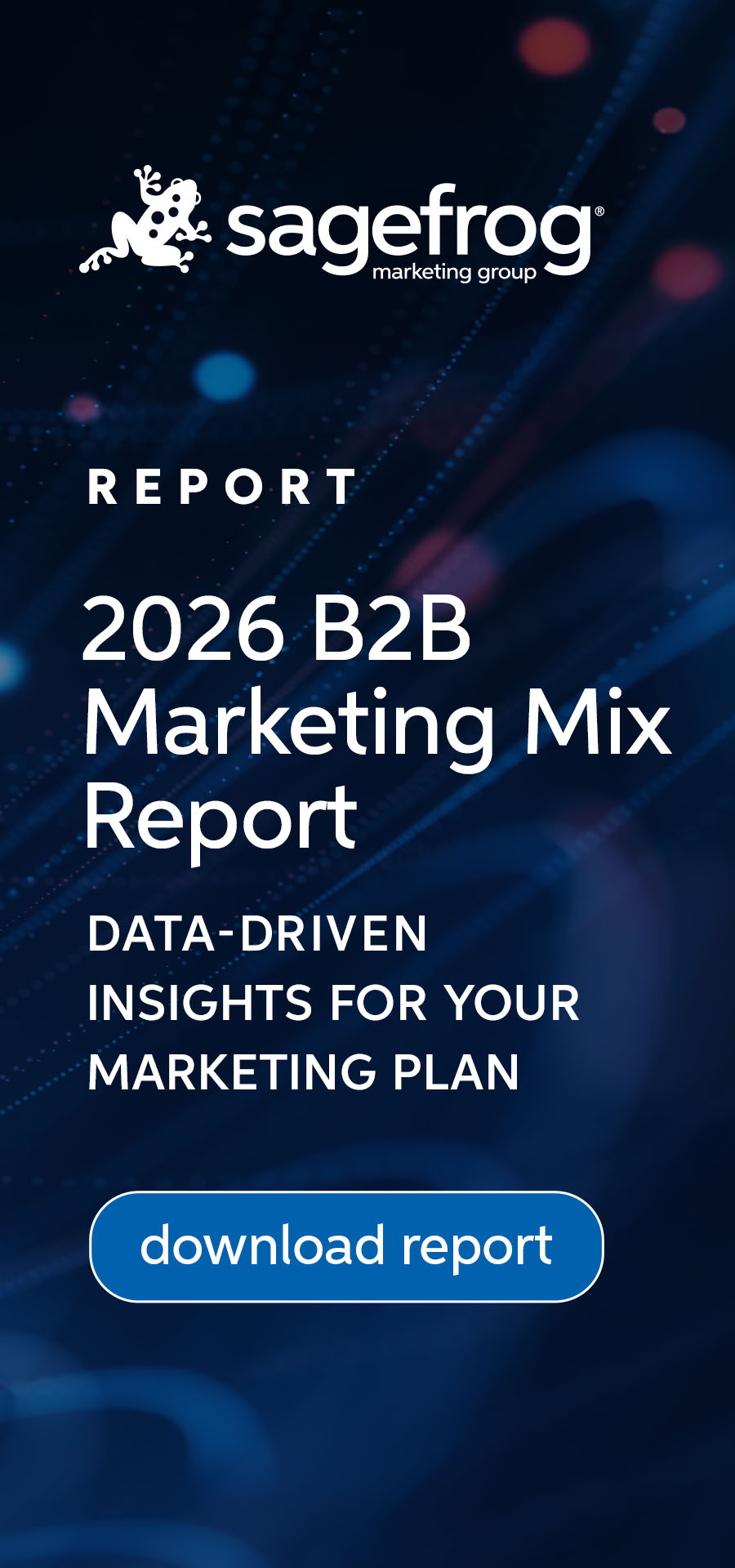Every year, Sagefrog’s B2B Marketing Mix Report delivers data-driven insights to help B2B marketers stay informed, agile, and ready for what’s next. This year marks the 19th edition of the report, which captures how marketing leaders across industries are adapting to new technologies, evolving buyer expectations, and a renewed focus on measurable growth.
What Is the 2026 B2B Marketing Mix Report?
Now in its 19th year, Sagefrog’s B2B Marketing Mix Report compiles feedback from B2B marketing professionals across healthcare, technology, industrial, and business services sectors. Respondents, who range from managers to executives, share how they allocate budgets, generate leads, and adopt emerging tools to stay competitive in 2026.
This year’s findings reveal a pivotal moment in B2B marketing—one defined by smarter data, stronger alignment, and sharper purpose. With 70% of marketers increasing their budgets this year, investment is flowing toward content marketing, AI tools, and branding.
Marketers aren’t just experimenting with new tools; they’re optimizing entire systems to move faster, think clearer, and connect more meaningfully.
Here are eight insights from this year’s report that are expected to shape B2B marketing in 2026.
1. Sales & Marketing Alignment Is the New Growth Engine
Misalignment remains one of marketing’s biggest obstacles—and greatest opportunities. Only 35% of organizations report full sales and marketing alignment, but those that do consistently outperform in lead quality, conversion rates, and revenue growth.
Teams that share goals, collaborate on handoffs, and maintain joint accountability are closing the gap between strategy and execution. In 2026, alignment will boost productivity and act as a growth strategy.
Actionable Tip: Audit your sales-marketing process quarterly to identify friction points and realign shared KPIs.
2. AI Is Fully Integrated—And Purposefully Applied
AI is no longer a novelty or a pilot project. Roughly half of marketers have adopted AI tools in their workflows, most commonly personalization engines (51%), generative AI (49%), and predictive analytics (47%).
As adoption matures, the conversation has shifted from curiosity to control. Marketers are setting ethical standards, refining use cases, and focusing AI investment where it drives measurable value, enhancing campaign precision, not replacing creativity.
Actionable Tip: Choose one workflow to automate intelligently in 2026, then measure its ROI before scaling AI elsewhere.
3. Branding Is a Business Imperative
Strong brands are no longer a “nice to have.” They’re a measurable driver of differentiation, retention, and growth. Forty-two percent of companies intend to prioritize a rebranding or brand refresh in 2026, while 44% will revisit their brand messaging within the next three years.
Brand strategy has officially become a business strategy, connecting marketing, sales, and customer experience under a unified story. In 2026, branding isn’t cosmetic. It’s essential.
Actionable Tip: Revisit your brand story every 2–3 years to ensure alignment with market changes and internal culture.
4. Data Is a Guide, Not Just a Report Card
The age of reporting for reporting’s sake is over. Marketers rank data and analytics as their top investment area for 2026, using closed-loop feedback systems to turn metrics into action.
AI and automation are helping teams analyze campaign data in real time, enabling quick adjustments to messaging, timing, and targeting. Data is no longer the end of the story; it’s the driver of every decision.
Actionable Tip: Establish a “review and react” cadence where insights translate into one immediate optimization each quarter.
5. Lead Quality Beats Lead Quantity
The 2026 report shows that the most successful marketers are focused on lead quality over volume. Qualified leads are increasingly coming from targeted digital channels such as content syndication, email marketing, paid search, and LinkedIn Ads, while broad outreach through traditional methods continues to decline.
Marketers are refining nurture strategies and leveraging automation to connect with prospects at the right time with the right message, transforming channel performance from a numbers game into a strategy game.
Actionable Tip: Refine your lead scoring to focus on engagement depth and intent, not just activity volume.
6. Marketing Automation Anchors the Stack
Automation continues to serve as the backbone of modern marketing operations. Marketing automation remains foundational, with widespread adoption across platforms like Zoho (44%), Salesforce (42%), and Pardot (38%).
These systems reduce manual effort, improve consistency, and make personalization scalable. In 2026, automation isn’t about replacing people but empowering them to do more meaningful work.
Actionable Tip: Map your tech stack to uncover integration gaps between marketing automation, CRM, and analytics systems.
7. Brand Foundations Deserve Regular Attention
Four in ten marketers have revisited their brand messaging or positioning in the past year. The reason? Rapid market shifts demand clarity and adaptability.
The strongest brands maintain internal alignment and external relevance, revisiting their foundations early and often to ensure their messaging resonates with customers and employees alike.
Actionable Tip: Host an annual internal brand check-in to evaluate how well your messaging aligns with customer perception.
8. The Future Is Still Human
Even as AI and automation redefine marketing, one truth remains: people connect with people. Authenticity and trust top the list of factors influencing B2B purchasing decisions in 2026.
Technology can amplify a message, but empathy, transparency, and human connection make it resonate. The most successful brands will be those that balance data and technology with genuine human insight.
Actionable Tip: Pair automation with empathy. Use data to personalize experiences without losing the human touch.
Where B2B Marketing Goes from Here
The 2026 B2B Marketing Mix Report captures an industry at peak adaptability. Budgets are rising, AI is advancing, and automation is streamlining, but what really separates top performers is clarity of purpose.
If 2025 was about acceleration, 2026 is about intention. Growth isn’t just about doing more. It’s about doing what matters most, better.
The takeaway is clear: the next era of B2B marketing will belong to the teams that know how to connect it all.
Download the full report: Sagefrog’s 2026 B2B Marketing Mix Report
See the data, insights, and trends shaping the future of B2B marketing.

